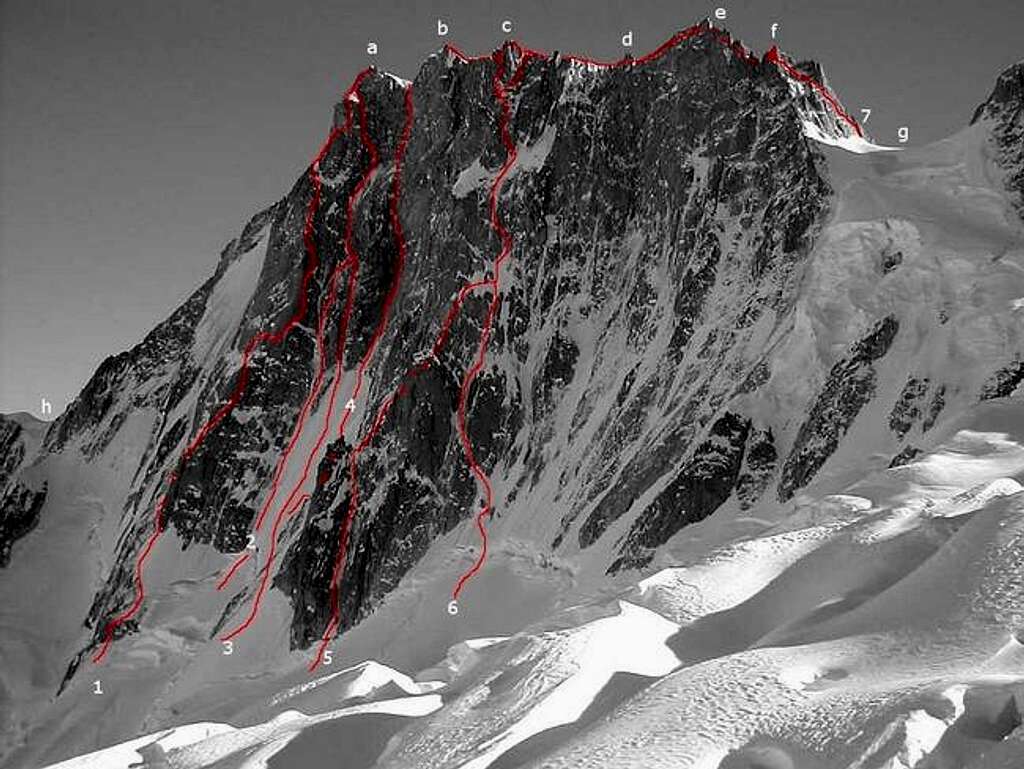(A) Pointe Walker (4208m) ...

(A) Pointe Walker (4208m) ...
(B) Pointe Whymper (4184m)
(C) Pointe Croz (4110m)
(D) Punta Elena (4045m)
(E) Punta Margherita (4066m)
(F) Pointe Young (3996m)
(G) Col Des Grandes Jorasses (3818m)
(H) Cold Des Hirondelles (3485m)
(1) Cassin route – Classic route (Cassin/Esposito/Tizzoni, 1938, TD+/ED1, 1200m)
(2) “Extreme Dream” (Boivin/Vionet-Fuasset, 1987, 1150, ED3, 1150m) It's basically a different start for the classic MacIntyre, far more difficult than the original but also rarely in conditions.
(3) MacIntyre - Colton / "Rollerwand" (Colton/MacIntyre, 1976, ED2, A1, VI/6, 90°, 1150m) Nowadays it's the most popular winter route on the North Face, slowly gaining on traffic over the Linceul. However, the demanding and elegant original route is very rarely followed. Being the crux of the route between the middle and upper icefield rarely in conditions, most of the parties link the R hand couloir of "Alexis" (not shown here) up to the upper icefield, and the last section of the Japanese route to the 4143m breach between Pt. Walker and Pt. Whymper.
(4) Japanese Couloir (Kanda/Kato/Miyazaki/Nakano/Saito, 1972, ED3?,1150m) While, as told before, the last section of the route is now a popular variation of the classic MacIntyre line, the entire original route has never been repeated. The lower section, until the beginning of the narrowest and deepest zone of the couloir, is the approach line to "Eldorado"
(5) This is the "Couloir Face Aux Periades" variant start of the classic Croz spur route. Was climbed (in descent) for the first time by legendary guide Armand Charlet and equally talented client Robert Greloz (who opened the classic north face of Triolet) returning from their attempt to the route in July 1934. It was used later by several parties mostly as escape route, and never gained popularity until the birth of modern ice equipment. It's more difficult than the original start, but safer. The line above the first tower is the classic route (Meier/Peters, 1935, 1,000m, TD+/ED1)
(6) The winter line now commonly used to climb the Croz spur. It's a combination of the start of the Slovenian route until the second icefield, plus the classic line. On the crux, between the second and third icefield, sometimes it does form a thin gully on the right of classic slanting cracks that may be faster to climb. This variation is not shown here because rarely in conditions. At the top of the route are marked the two possible exit lines - the original on the left being more straightforward, while the right one, opened by Luis Lachenal and Gaston Rebuffat, easier if in condition).
(7) West Ridge (Jones/Young/Knubel, 1911, D, IV, 300m of height gain x 1km of development) A beautiful route, with incredibily aestetical and airy sections. Very reccomended as a continuation of the Rochefort ridge. The Canzio bivouac is exactly at the start of the route, on the snow saddle below the "7", on the opposite (italian) side




